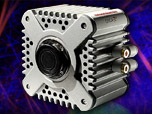Image Galleries
Featured Article
 Electron Multiplying Charge-Coupled Devices (EMCCDs)
Electron Multiplying Charge-Coupled Devices (EMCCDs)
By incorporating on-chip multiplication gain, the electron multiplying CCD achieves, in an all solid-state sensor, the single-photon detection sensitivity typical of intensified or electron-bombarded CCDs at much lower cost and without compromising the quantum efficiency and resolution characteristics of the conventional CCD structure.
Product Information
Interactive Java Tutorials
Two Phase CCD Clocking
A two phase charge transfer CCD clocking scheme employs four gates for each pixel, with adjacent gates connected together as pairs. The two phase CCD scheme requires a more complex clocking arrangement than that described for the four phase and three phase CCD architectures. The shift register illustrated in this tutorial includes two pixel elements, for a total of eight gates aligned along a common axis to form a column. Each gate pair is connected to an alternate clock line and one of the gates in each pair is designed with an increased n-type doping level beneath the gate. When voltage is applied to the gate pair, the gate having the increased doping level has a more positive potential, which increases the depth of the charge storage area and results in a "step" in the potential energy profile.
The nature of electrostatic forces in the silicon substrate beneath the gates is determined by the voltage level applied to a particular gate by the clock input signal. High level voltages induce the formation of a potential "well" beneath the gate, whereas low level voltages form a potential barrier to electron movement. Clock lines are alternately pulsed, resulting in the charge packets (illustrated as blue "electrons" in the tutorial) being shifted along the CCD in a direction that is determined by the position of the extra doping. The requirement for only two clock phases reduces the complexity of the device, but at the expense of extra processing.






